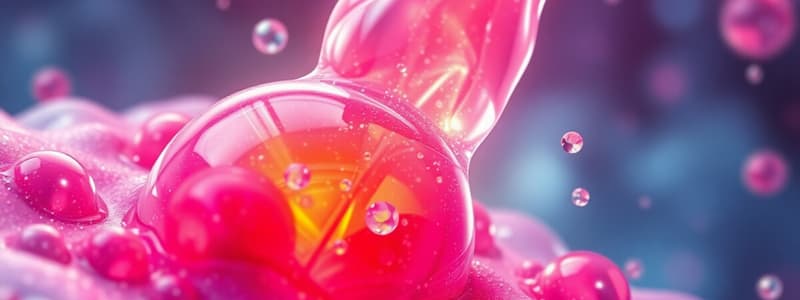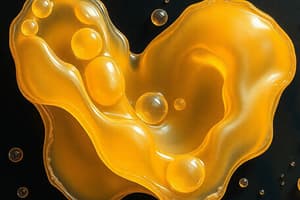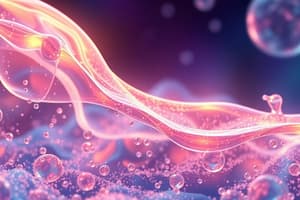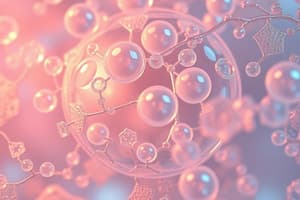Podcast
Questions and Answers
What effect does increasing the concentration of cefuroxime beyond 20% have on the drug solution?
What effect does increasing the concentration of cefuroxime beyond 20% have on the drug solution?
- It promotes better diffusion of the drug into the hydrogel.
- It enhances the drug loading capacity of the hydrogel.
- It causes the solution to agglomerate immediately after chitosan addition. (correct)
- It results in a quicker release of the drug from the hydrogel.
Which release model could potentially enhance the understanding of hydrogel drug delivery systems?
Which release model could potentially enhance the understanding of hydrogel drug delivery systems?
- Korsmeyer–Peppas model (correct)
- Fickian diffusion model
- Zero-order release model
- Michaelis-Menten kinetics
What factor influences the rate of drug diffusion into the hydrogel?
What factor influences the rate of drug diffusion into the hydrogel?
- Concentration of chitosan
- Environmental temperature
- Hydrogel pore size and drug molecular nature (correct)
- Hydrogel molecular weight
Which physical method is described in the context of hydrogel drug delivery systems?
Which physical method is described in the context of hydrogel drug delivery systems?
What is the maximum drug release percentage achieved by the microspheres at a pH of 6.8 after 14 hours?
What is the maximum drug release percentage achieved by the microspheres at a pH of 6.8 after 14 hours?
What is a significant drawback of passive diffusion in hydrogel drug loading?
What is a significant drawback of passive diffusion in hydrogel drug loading?
How long does the hydrogel film remain intact before completely dissolving in a physiological environment?
How long does the hydrogel film remain intact before completely dissolving in a physiological environment?
Which of the following is NOT typically involved in hydrogel drug loading methods?
Which of the following is NOT typically involved in hydrogel drug loading methods?
Which of the following groups interacts to facilitate drug release from the microspheres?
Which of the following groups interacts to facilitate drug release from the microspheres?
In drug release kinetics, which parameter is crucial for the Korsmeyer–Peppas model?
In drug release kinetics, which parameter is crucial for the Korsmeyer–Peppas model?
What effect does increasing polymer concentration have on drug release from the microspheres at pH 6.8?
What effect does increasing polymer concentration have on drug release from the microspheres at pH 6.8?
What type of hydrogel allows for covalent bonding with active small molecules?
What type of hydrogel allows for covalent bonding with active small molecules?
Compared to conventional tablets, how do the microspheres perform in terms of immediate drug release rates?
Compared to conventional tablets, how do the microspheres perform in terms of immediate drug release rates?
What is the primary characteristic of the drug release models used in the study?
What is the primary characteristic of the drug release models used in the study?
Which of the following local anesthetics was associated with the microsphere drug release system?
Which of the following local anesthetics was associated with the microsphere drug release system?
What is the role of pH in the drug release mechanism from the microspheres?
What is the role of pH in the drug release mechanism from the microspheres?
What is the primary benefit of incorporating ammonia during the preparation of chitosan hydrogels?
What is the primary benefit of incorporating ammonia during the preparation of chitosan hydrogels?
Which mechanism describes the initial drug release behavior observed when a hydrogel is implanted into the body?
Which mechanism describes the initial drug release behavior observed when a hydrogel is implanted into the body?
What type of binding allows drugs to move freely within the hydrogel network?
What type of binding allows drugs to move freely within the hydrogel network?
What characteristic of hybrid hydrogels prepared by mixing lipids and chitosan contributes to their effectiveness?
What characteristic of hybrid hydrogels prepared by mixing lipids and chitosan contributes to their effectiveness?
Which of the following is true regarding drug release models in hydrogel systems?
Which of the following is true regarding drug release models in hydrogel systems?
What effect does the addition of drug-loaded liposomes to hydrogels have on their properties?
What effect does the addition of drug-loaded liposomes to hydrogels have on their properties?
The charge density of chitosan in hydrogels can affect which aspect of drug release?
The charge density of chitosan in hydrogels can affect which aspect of drug release?
Which of the following factors does NOT influence drug release kinetics from hydrogels?
Which of the following factors does NOT influence drug release kinetics from hydrogels?
Which drug release model is mentioned as helpful for understanding advanced hydrogel drug delivery systems?
Which drug release model is mentioned as helpful for understanding advanced hydrogel drug delivery systems?
What is a potential effect of using a polystyrene orifice plate in hydrogel drug delivery?
What is a potential effect of using a polystyrene orifice plate in hydrogel drug delivery?
What challenge arises when increasing cefuroxime concentration in the hydrogel formulation?
What challenge arises when increasing cefuroxime concentration in the hydrogel formulation?
What role does passive diffusion play in hydrogel drug loading processes?
What role does passive diffusion play in hydrogel drug loading processes?
In hydrogel drug delivery systems, what is primarily governed by the hydrogel pore size?
In hydrogel drug delivery systems, what is primarily governed by the hydrogel pore size?
What is primarily responsible for forming covalent bonds in the hydrogel systems described?
What is primarily responsible for forming covalent bonds in the hydrogel systems described?
Which factor is NOT associated with the drug diffusion process into the hydrogel?
Which factor is NOT associated with the drug diffusion process into the hydrogel?
Which aspect is essential for the effectiveness of hydrogel drug loading systems mentioned?
Which aspect is essential for the effectiveness of hydrogel drug loading systems mentioned?
What is the primary factor contributing to the differences in drug release rates between microspheres and commercial tablets?
What is the primary factor contributing to the differences in drug release rates between microspheres and commercial tablets?
At pH 1.2, what percentage of drug release was observed after 240 minutes?
At pH 1.2, what percentage of drug release was observed after 240 minutes?
In drug release kinetics from the studied microspheres, how does an alkaline environment compare to an acidic one?
In drug release kinetics from the studied microspheres, how does an alkaline environment compare to an acidic one?
What was the maximum drug release percentage of conventional tablets after 10 hours?
What was the maximum drug release percentage of conventional tablets after 10 hours?
Which aspect of the drug release process is influenced by the presence of –NH2, –OH, and –COOH groups?
Which aspect of the drug release process is influenced by the presence of –NH2, –OH, and –COOH groups?
What is a significant characteristic of the hydrogel film in terms of drug release duration?
What is a significant characteristic of the hydrogel film in terms of drug release duration?
Which parameter is crucial for understanding the kinetics of drug release from microspheres?
Which parameter is crucial for understanding the kinetics of drug release from microspheres?
What was the effect of increasing polymer concentration on the drug release at pH 6.8?
What was the effect of increasing polymer concentration on the drug release at pH 6.8?
What characterizes sustained drug release from hydrogels compared to rapid drug release?
What characterizes sustained drug release from hydrogels compared to rapid drug release?
Which factor is least likely to affect the initial explosive release of drugs from a hydrogel upon implantation?
Which factor is least likely to affect the initial explosive release of drugs from a hydrogel upon implantation?
When considering drug release kinetics from hydrogels, what does an increase in the apparent charge density of the polymer typically lead to?
When considering drug release kinetics from hydrogels, what does an increase in the apparent charge density of the polymer typically lead to?
Which statement best describes the role of liposomes in hydrogel drug delivery systems?
Which statement best describes the role of liposomes in hydrogel drug delivery systems?
In the context of drug-loaded liposomes incorporated into hydrogels, what is one likely consequence of their addition?
In the context of drug-loaded liposomes incorporated into hydrogels, what is one likely consequence of their addition?
Which of the following options is most closely associated with initial rapid drug release from hydrogels?
Which of the following options is most closely associated with initial rapid drug release from hydrogels?
What is a potential impact of reducing the charge density of chitosan during hydrogel preparation?
What is a potential impact of reducing the charge density of chitosan during hydrogel preparation?
The formation of hydrogen bonds within hydrogels primarily affects which aspect of drug delivery?
The formation of hydrogen bonds within hydrogels primarily affects which aspect of drug delivery?
Flashcards are hidden until you start studying
Study Notes
Chitosan Hydrogel and Drug Delivery
- Chitosan hydrogels are used in drug delivery due to their biocompatibility and biodegradability.
- Chitosan hydrogels can be loaded with drugs through passive diffusion, where the drug diffuses into the hydrogel based on the pore size and the drug's molecular nature.
- Drug loading in hydrogels can also be achieved through covalent bonding, where the drug is chemically attached to the chitosan polymer.
- Drug release from chitosan hydrogels can be pH dependent, meaning the rate of release can be controlled by the acidity or alkalinity of the environment.
- The presence of ammonia during the hydrogel preparation process can reduce the charge density of chitosan, influencing the formation of hydrogen bonds, and affecting drug release.
- Liposomes loaded with drugs can be incorporated into chitosan hydrogels without altering the hydrogel's rheological properties, suggesting potential for targeted drug delivery.
- Drug release mechanisms in hydrogels can be broadly categorized as rapid and sustained drug release.
- Hydrogels can have non-covalent interactions with drugs, allowing for movement of the drug within the hydrogel network.
- An initial rapid drug release from the hydrogel occurs due to the concentration gradient formed between the drug and the surrounding environment.
- The rate of drug release from hydrogels gradually decreases as the concentration of the drug increases in the surrounding environment.
Drug Release Models
- Drug release models like Korsmeyer–Peppas and Weibull can be used to understand and improve the design of hydrogel drug delivery systems.
Chitosan Hydrogel Applications
- Chitosan is a biocompatible and biodegradable polymer used in drug delivery systems.
- It can be synthesized through the deacetylation of chitin.
- Chitosan is a cationic polysaccharide and its positive charges are related to its -NH2 group.
- Chitosan can be used to design advanced drug delivery systems.
- Drug release models like the Korsmeyer–Peppas and Weibull can aid in the design and understanding of drug delivery systems.
Chitosan Hydrogel Drug Loading Methods
- Most hydrogel drug loading methods involve placing the hydrogel in a drug-containing medium.
- Drugs can diffuse into the hydrogel based on the hydrogel's pore size and the drug's molecular nature.
- The diffusion process prolongs drug loading time.
- Chitosan hydrogels can encapsulate a large amount of drug.
Factors Affecting Drug Release from Chitosan Hydrogels
- Hydrogel film is a pH-dependent release carrier for local anesthetics.
- Drug release can be sustained for up to 24 hours.
- The hydrogel film completely dissolves in the physiological environment within 24 hours without leaving toxic metabolites.
- Ammonia addition can reduce the apparent charge density of the chitosan chain, leading to hydrogen bond formation.
Drug Release Mechanisms
- Drug release is impacted by the physical and chemical properties of hydrogels.
- Two main mechanisms are rapid and sustained drug release.
- Drugs can non-covalently bind to hydrogels, allowing for free movement of the drug within the hydrogel network.
- An initial burst release occurs due to the concentration gradient between the drug and its surrounding environment.
- This gradient slows down drug release from the hydrogel.
- Drug release is pH-dependent with faster release rates in acidic environments.
- Polymer concentration affects drug release: an increase in polymer concentration leads to a decrease in drug release.
Drug Release Applications
- Chitosan hydrogels have been shown to be effective for drug delivery applications.
- Studies show that chitosan hydrogels have been used to deliver various drugs for different therapeutic purposes.
- These include local anesthetics, anti-inflammatory drugs, and antibiotics.
Future Directions
- Chitosan hydrogel research is evolving to explore new drug release models and improve the design of drug delivery systems.
- Efforts focus on improving the control of drug release, targeting specific locations, and enhancing the safety and efficacy of drug delivery.
- Further exploration on the design and manufacture of biocompatible and bioresorbable drug delivery systems made with chitosan is needed.
Studying That Suits You
Use AI to generate personalized quizzes and flashcards to suit your learning preferences.




